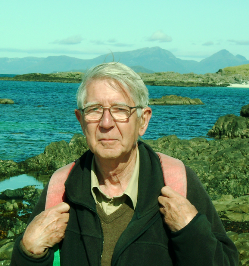 Distinguished field-based igneous petrologist who studied under Wager and was noted for his work on the Rum layered intrusion.
Distinguished field-based igneous petrologist who studied under Wager and was noted for his work on the Rum layered intrusion.
Charles ‘Henry’ Emeleus came from County Antrim, Northern Ireland. He graduated with first class honours in Geology, from Queen’s University (Belfast, Northern Ireland) in 1952. His research interests in the British Palaeogene Igneous Province developed early in his career, when he remained at Queen’s for a research MSc (1953) based on the Mourne Mountains igneous centre, under the supervision of J E Richey. He subsequently received a DPhil from Oxford University in 1957, for his work on the Slieve Gullion centre, supervised by L R Wager.
Henry was appointed lecturer in Geology at Durham University in the same year, and spent most of his career there. He was promoted Reader in 1979 and served as Head of Department (1986-87). He retired in 1994, but remained very research-active and was awarded the Chancellors Medal of Durham University in 2014 and elevated to Emeritus Professor in 2016.
Field geologist
Henry’s expertise encompassed the broad spectrum of igneous petrology. He was first and foremost a field geologist, and always considered field investigations an essential foundation on which to base further laboratory investigation. Henry had long-term interests in the petrogenesis of Proterozoic syenites from the Gardar Province in southwest Greenland. His first expedition was in 1955, when he spent the summer mapping the Kûngnât Complex with B G J Upton (then also at Oxford University).
This trip marked the first of more than 15 field seasons in SW, E & NE Greenland, working with the Danish Geological Survey, often in very challenging and difficult terrain. In addition to the substantial body of work on the emplacement and solidification of the Gardar syenite intrusions, he carried out, with colleagues and students, investigations on kimberlitic rocks in southern Greenland and the Palaeogene basalts of Scoresby Sund and Hold with Hope in East Greenland.
Henry’s earliest research on the Isle of Rum was published in papers, co-authored with C J Hughes and A C Dunham in 1957 and 1965 respectively, on the felsic intrusive rocks there. Over time his fascination with the layered intrusion developed and his life-long work, with co-workers and students, on various aspects of the layered cumulates is one of the main reasons Rum became one of the most well-known layered intrusions in the world.
Maps & memoirs
After retirement, Henry undertook a number of significant projects under contract to the British Geological Survey. These included revising the geological maps of Mull, the Small Isles and Ardnamurchan, in Scotland. In 1994, he produced the superb 1:20,000 map of the Isle of Rum, published by Scottish Natural Heritage, and now out of print. He also wrote numerous memoirs and texts on British igneous geology. Perhaps the most iconic of these are his BGS memoir ‘Geology of Rum and the adjacent Isles’ (1997) and ‘The Palaeogene Volcanic Districts of Scotland’ (2005, co-authored with B Bell). Like his other texts, these are superlative examples of accessible and informative scientific writing, and beautifully illustrated.
In recognition of his distinguished achievements over the course of his career, he received many awards and honours. He was awarded a DSc from Queens University (Belfast), the Clough Medal of the Edinburgh Geological Society in 1994-95 and the inaugural Collins Medal of the Mineralogical Society of Great Britain and Ireland in 2010. The latter honour is awarded ‘….annually to a scientist who, during a long and active career, has made an outstanding contribution to pure or applied aspects of Mineral Sciences and associated studies’. Henry was also awarded the Prestwich Medal of the Geological Society of London in 2016 for his ‘contribution to the advancement of science’.
Railways
Henry’s interests encompassed much more than the geosciences. When he was not thinking about geology he would be reading about railways or playing trains. In particular he modeled the Great North of Scotland Railway in O Gauge, hand built track, point work and rolling stock. His knowledge of railways was extensive and encyclopedic.
Henry passed away on Saturday 11 November 2017. He will be remembered by all who knew him as a modest and gentle man, with a dry and ready sense of humour and a twinkle in the eye. He was generous to a fault with that most valuable of commodities: his time. His great knowledge and experience was always enthusiastically shared. A R McBirney once remarked that Henry ‘....never asserts himself, but when he says something, one should listen, because he knows what he is talking about.’
Perhaps the greatest legacy that he leaves to geology is the energy and enthusiasm he inspired and fostered in several generations of earth scientists working in the arena of igneous petrology. He leaves behind his wife, Ruth, children Katherine, John and Lucy, and grandchildren. He will be greatly missed by all who knew him.
By Brian O’Driscoll, with Jon Gluyas and Madeleine Humphreys